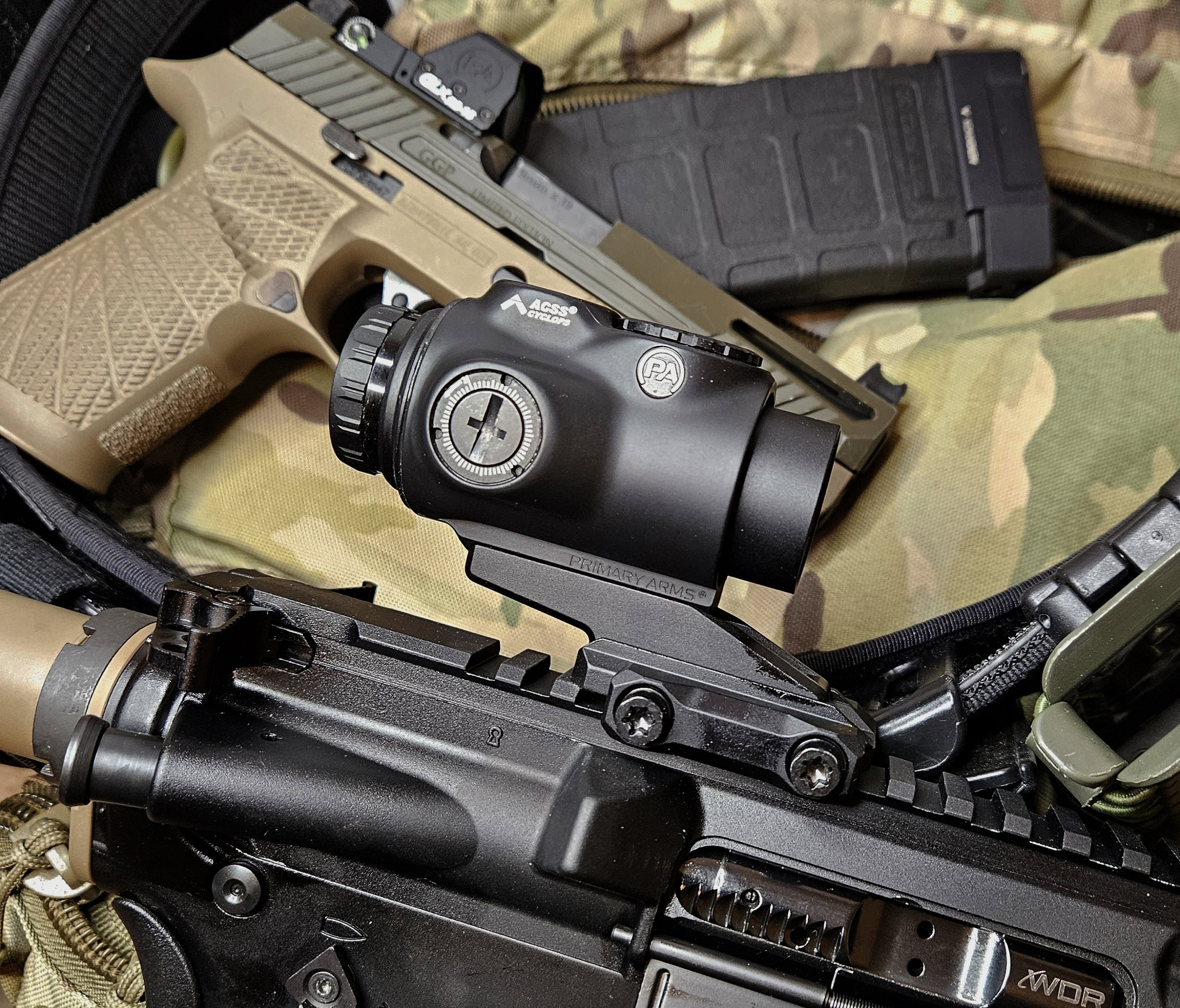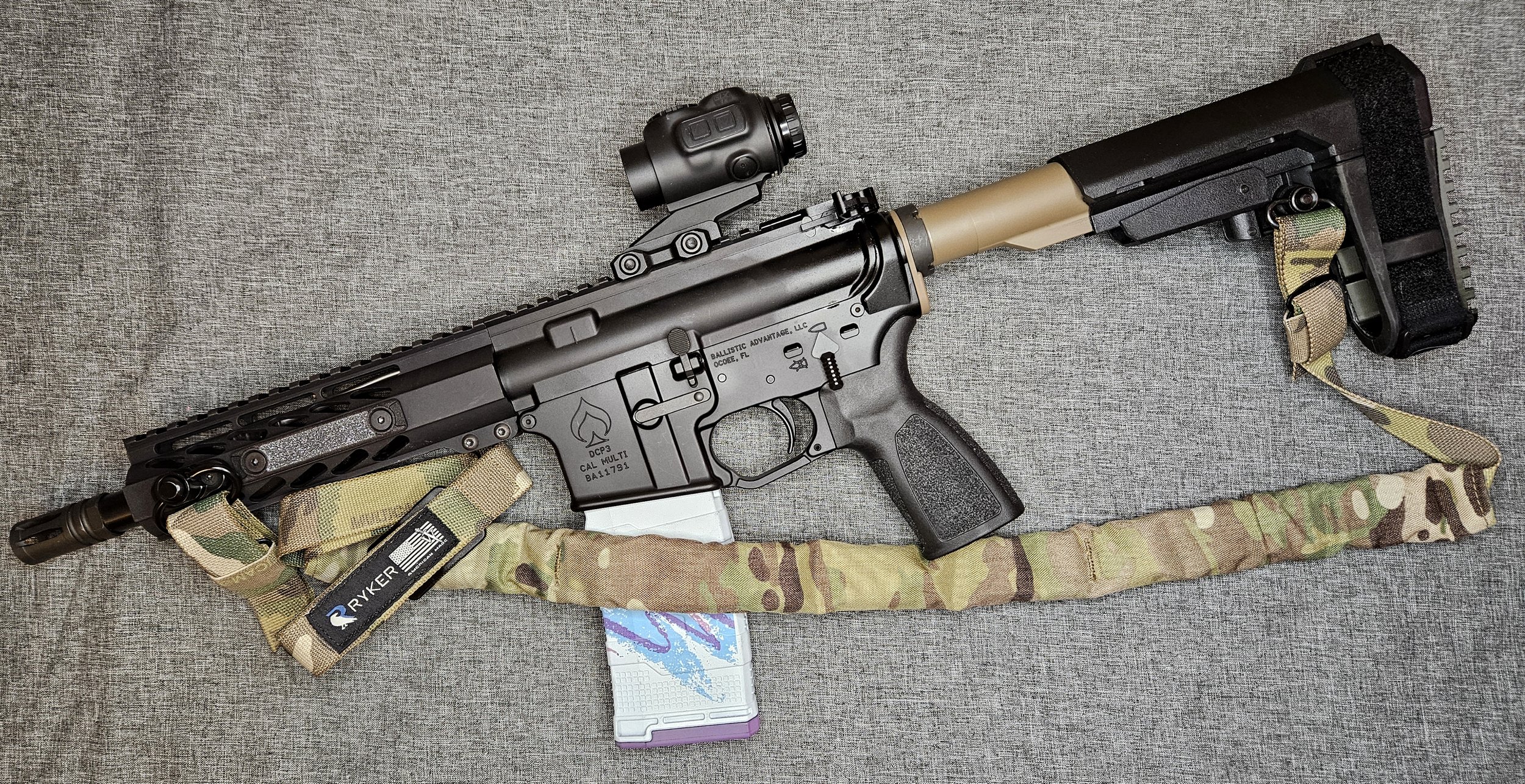Global Ordnance
Monolith Review
A little over a year ago, Global Ordnance teased their Monolith rifle and pistol. As is usual when introducing a new rifle, it took some time to get them into production. But alas, here we are. I was one of the first few to receive one to fully try out and review! The Monolith rifle has a ton of features over your standard AR15. I think you will like hearing about them.
To start with, the Global Ordnance Monolith is not your fathers AR15. Yes, most of the parts are semi-interchangeable with a standard AR15. Some of those compatible parts are the complete upper receiver assembly, trigger, and the safety selectors. For clarification, the Monolith upper can be used on a standard AR, but a standard AR upper can not be used on the Monolith. Other parts are proprietary, but in a good way.
You might ask what is in the name “Monolith”? That is where some of the improvements come in. The Monolith is designed with a single piece barrel assembly. So the muzzle brake, gas block, barrel, and barrel extension are all one machined piece. Unlike an AR15 where those would be four separate pieces. The Monolith also utilizes a 45 degree gas tube that uses a fuel injection style fitting. This eliminates needing a roll pin to hold the gas tube in place. So by re-engineering these parts, Global Ordnance has made a stronger and lighter barrel assembly that has less attached components, thus making a barrel system that has less failure points.
The first version of the Monolith comes with a Keymo style muzzle brake. As mentioned, this muzzle brake is machined into the barrel, so it is not removable. The Keymo muzzle brake was selected because it is a common muzzle device that can be used with a bunch of different suppressors. It also works very well as a muzzle brake, if you are not wanting to mount a suppressor, or live in a state that does not allow them. Threaded barrel options may be available in the future so that you can install your own muzzle brake of choice.
On the rear of the one piece barrel is the barrel extension. The barrel extension is what the bolt locks into to keep the cartridge in the chamber while firing. It also has cut outs, or feed ramps, machined into it. These help guide the cartridges out of the magazine and into the chamber. The Monolith uses an AR10 size extension. This is larger than an AR15 style, so you get more strength. The barrel is made from 4150 ordnance grade steel (the stuff they use on machine gun barrels) for added strength and barrel life. Therefore the extension is also 4150 since it is machined with the barrel. The barrel assembly/barrel extension is then thermal fit into the upper receiver. This is also done for strength, but also gives better accuracy than the slip fit of most AR15 barrels.
Instead of the standard AR style recoil buffer system, the Monolith uses a bufferless system. The recoil system, as well as the bolt, are housed inside the upper receiver. This allows various things, but the main purpose is to get rid of the AR15's buffer tube.
By getting rid of the buffer tube, one can install a true folding stock. Global Ordnance went one step farther and built the folding stock mechanism into the firearms lower receiver. The stock folds to the left side of the rifle. This gives you a rifle that can fire with the stock folded, all day long. The stock is a F5 ACR style modular stock system. The Monolith's stock is adjustable for length using some side buttons. It also has a little cheek piece that can be popped up higher. This is nice if using magnified optics. Inside the stock is also a little storage compartment for batteries or whatever. You can only access the compartment when the stock is folded. So if the stock is in the shooting position, those batteries are not falling out.
The manual of arms on the Monolith is a little different from a standard AR15. The Monolith's charging handle is a folding lever, forward of the receiver. Not the rear style like in that standard AR I keep mentioning. So the charging handle sits in the rifle's handguard, toward the top picatinny rail, on the left side. It folds forward when not in use. Otherwise, the handguard is a pretty standard MLOK style with a top rail. The charging handle can also be swapped over to the right side. The forward style charging handle works very well and is not hard to get used to.
One of my favorite features of the Monolith is that it is full ambidextrous. I already mentioned how the charging handle can be reversed, but there is way more. To start with, the lower receiver has full ambi controls. This includes the mag release, bolt release, and the safety. The safety comes with a short and long paddle, they are reversible to either side. If you want to take the grip off, you can change the safety from 90 degrees to 45. Both sides of the magazine release use a square button. The bolt releases are extended on the bottom to make it far easier to lock the bolt back. A key feature to the Monolith is the ability to drop the open bolt by just pushing down on the dust cover.
There are only a few other things about that Monolith that need to be shared. First up is the trigger. It is a flat mil-spec trigger. It is slightly better than a standard mil-spec trigger. Its pull weight is about 5.5 pounds on this rifle and feels like it has a little less creep. Global Ordnance also spec’d out a B5 grip. The grip has good texture and matches the rifle nicely. Lastly, the Monolith only weighs 5.82 pounds out of the box! With a Primary Arms 1-10x28 and a full magazine, it only weighs 7.8 pounds. So the whole package is pretty light.
The Monolith is a great rifle, but it does have some quirks. It comes with an extra recoil spring assembly. The extra is supposed to be for suppressor use. However, when I ran the Monolith with a suppressor and the “suppressor” spring, I had 2 short strokes and a failure to lock the bolt back on an empty magazine. This was in about 3 magazines. I switched back to the normal spring and it worked great, even with the suppressor. I ran around 200 rounds suppressed, after switching the recoil spring back to the original one. Other than those failures, the Monolith ran like a champ. Another problem I ran into was that I could not pull the charging handle back far enough to charge the rifle. After inspection, the charging handle carriage was binding where it goes through the receiver. I smoothed it out with a round file and have not had any problems since. The manufacturer has now since put a chamfer on the part, eliminating that problem. Lastly, the stock can flex a little if you really pull the rifle back into your shoulder. I never noticed it while shooting the Monolith, only when I was dry firing it.
Now to the good stuff. I really like how the Monolith shoots. The lightweight really makes it a joy to use. You can move from target to target quickly or get reasonable accuracy out of it. It averaged from 1.4 inches to 2 inches at 100 yards with almost any ammunition, from 55 grain up to the 75 grain. Global Ordnance supplied some 69 grain match ammo for the review, it grouped about 1.6 inches. I also really appreciated being able to drop the bolt by just pushing the dust cover down. The folding charging handle also works well as a kick stand so your hot suppressor does not touch the table and melt stuff. I also appreciated the folding stock, it is nice to have folding abilities in a rifle. Probably my favorite aspect of the Monolith is the one piece barrel assembly. Not only does it eliminate parts from the rifle, it is just a cool piece of engineering.
To improve the Monolith, I did add a few parts. Because I did not care for the trigger, I installed a flat Geissele SSP trigger courtesy of Primary Arms. This made a drastic improvement in how it feels and shoots. I am just not a fan of mil-spec triggers. During the testing, I also had a Holosun red dot mounted on it at first. Mainly it ran the Primary Arms SLx 1-10x28 with their Nova fiber dot reticle. This was a great choice for the Monolith. It let me do accuracy testing at 100 yards and do fast work up close. The Monolith was fine by itself, I just like better triggers. Plus, you can’t really do much without some sort of sight.
If you are looking for an AR that is not an AR, but better, the Global Ordnance Monolith might be it. This rifle has all the features anyone could want. Plus the monolithic barrel assembly is just a great improvement. I enjoy the lightweight and ambi features of the Monolith too. Definitely go take a look at the Monolith, especially if you are looking for something different than your standard AR15.
Firearms Insider Reviews - Key Points
Claim to Fame:
Advanced AR15 style rifle
Target Market:
Anyone wanting an ARish rifle with the features mentioned in the review
Features, Benefits, and Specifications of this product:
Caliber: 5.56x45mm
Bufferless recoil system
Monolithic 1 piece barrel
Barrel Length: 16.1"
Barrel Material: 41v50 Black Nitride
Barrel Twist: 1:7
Gas Length: Mid Length with 45 degree port
Muzzle Device: Integrated Dead Air KeyMo 2-Port Brake
Heavy Duty AR10 size bolt
Safety: Ambidextrous Manual Safety
Weight: 5lb 14oz
Overall Length: 24.5" - 31.25"
Charging Handle: Forward Side Folding - swappable from left to right
Grip: B5 Systems P-Grip
Trigger: Flat AR-15 Trigger
Stock: F5 Modular Adjustable Folding Stock
Bolt Release : Ambidextrous with EP Cover Drop
Magazine Release : Ambidextrous
What other aesthetic options or finishes are available?
What others are saying?:
5 stars at GlobalOrdnance.com
I like that you did away with the two things I dislike about the ar 15. The buffer tube and the charging handle. I like the side charging handle and no buffer tube.
Link to other reviews:
Price point:
MSRP = $1234.99
Retail = Same
I need it now! Availability:
Global Ordnance, Primary Arms, or your local gun store
Our Rating:
Pros:
One piece barrel assembly
308 size bolt for added strength
No buffer tube
Lightweight
Ambi controls
Built in folding stock
Cons:
Harder to charge compared to standard AR
Charging handle locked up (current models have been fixed)
Stock flexes a little bit
Score: 8.00 Great
Favorite Link: Primary Arms SLx 1-10x28 ACSS NOVA Review



























































